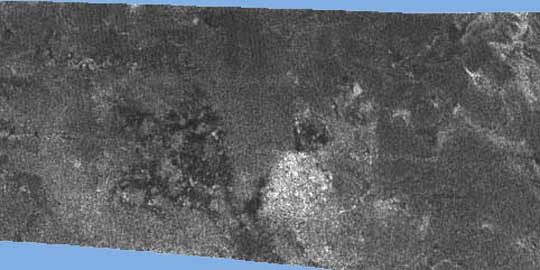|
 This radar image of the surface of Saturn's moon Titan was acquired on October 26, 2004, when the Cassini spacecraft flew approximately 1,600 kilometers (994 miles) above the surface and acquired radar data for the first time. This radar image of the surface of Saturn's moon Titan was acquired on October 26, 2004, when the Cassini spacecraft flew approximately 1,600 kilometers (994 miles) above the surface and acquired radar data for the first time.
Brighter areas may correspond to rougher terrains and darker areas are thought to be smoother. This image highlights some of the darker terrain, which the Cassini team has nicknamed "Si-Si the Cat" after a team member's daughter, who pointed out its cat-like appearance. The interconnected dark spots are consistent with a very smooth or highly absorbing solid, or could conceivably be liquid.
The image is about 250 kilometers (155 miles) wide by 478 kilometers (297 miles) long, and is centered at 50 N, 54 W in the northern hemisphere of Titan, over a region that has not yet been imaged optically. The smallest details seen on the image vary from about 300 meters (984 feet) to 1 kilometer (.62 mile).
The data were acquired in the synthetic aperture radar mode of Cassini's radar instrument. In this mode, radio signals are bounced off the surface of Titan.
The Cassini-Huygens mission is a cooperative project of NASA, the European Space Agency and the Italian Space Agency. The Jet Propulsion Laboratory, a division of the California Institute of Technology in Pasadena, manages the Cassini-Huygens mission for NASA's Science Mission Directorate, Washington, D.C. The Cassini orbiter and its two onboard cameras were designed, developed and assembled at JPL. The instrument team is based at NASA's Jet Propulsion Laboratory, Pasadena, Calif.--NASA
More on Cassini’s magnificent mission...
|